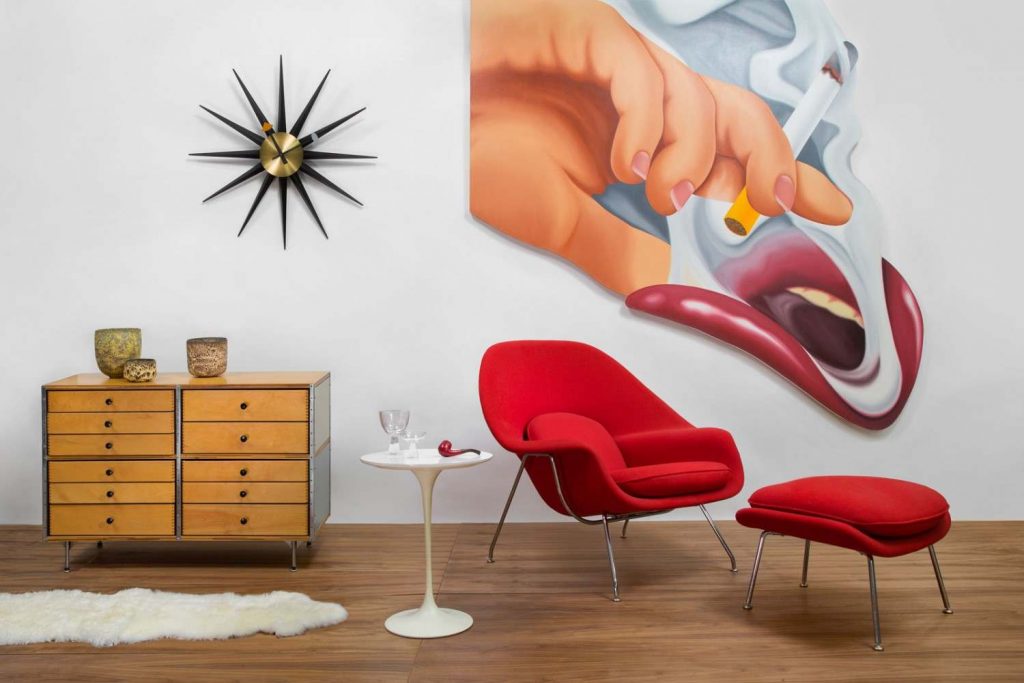
Bloomfield Hills, Mich., Oct. 18, 2016— Cranbrook Art Museum announces two new exhibitions opening alongside The Truth Is I Hear You on November 19 that will showcase unique objects from the Museum’s extensive collections.
The first is Cranbrook Time Machine: Twentieth-Century Period Rooms, the third installment in a curatorial series that rethinks historic methods of displaying artworks in a museum. This exhibition uses the period room, a domestic space built inside the museum, to simulate the original habitat or context of an artwork or historical object. It will remain open through March 19, 2017.
The exhibition draws from both the art and science collections of Cranbrook and beyond to reimagine four distinct periods significant to Cranbrook’s own history and the evolution of the 20th-century domestic landscape:
The Naturalist’s Athenaeum
Devoted to the Arts and Crafts movement that inspired Cranbrook’s founders, George and Ellen Scripps Booth, in the early 20th century, The Naturalist’s Athenaeum explores the ethos of the movement and the study of the natural world. The athenaeum, a sanctuary reserved for literary and scientific learning, is inhabited by artworks, handicraft objects, rare books and natural specimens that speak to a mindset that champions the intricacies of nature and human skill without the interference of technological production and artificiality.
The Bachelor Pad
Evoking mid-century modernism in America birthed at Cranbrook Academy of Art, The Bachelor Pad consists of two spaces: an exterior courtyard sculpture garden and an interior environment indicative of an idealized unmarried man. This space contrasts a familiar design narrative with a subtext of how a new modernist masculinity was constructed through consumer goods. The room is populated with furniture by modern masters such as George Nelson, Eero Saarinen and Charles Eames and seemingly benign objects—ashtrays, tumblers, cocktail shakers—that were propagated by magazines like Playboy as assertions of maleness.
The Cosmic Cave
A look into the experimental living environments of the 1970s, The Cosmic Cave is an immersive experience that takes its inspiration from speculative thinking of the era, including time travel, transcendental meditation, and the Afrofuturist philosophies of Sun Ra. A psychedelic living environment by Cranbrook alum Urban Jupena (Cave Rug, 1970) envelops the space and is accompanied by artworks ranging from ancient Egyptian artifacts to a sound work by contemporary artist Ingrid LaFleur. The space is a physical experiment in collapsing the past, present, and future.
A Semiotic Funhouse
The exploration of how an object’s form could be derived from its content or meaning, referred to as “product semantics,” was pioneered at Cranbrook in the 1980s. In A Semiotic Funhouse, pluralistic notions of taste are addressed in a room of furniture, graphics, and product models dedicated to the postmodernist sensibilities of historical reference, linguistic play, geometric formalism, and the anti-aesthetic of bad taste.
Poetically transporting the viewer back in time, these distinct and theatrically assembled rooms conjure an eclectic array of spaces and their imagined inhabitants.
Previous exhibitions in our curatorial series that rethinks historic methods of displaying artworks includes The Cranbrook Hall of Wonders (2014), which adapted the non-hierarchal taxonomy of the sixteenth-century Cabinets of Curiosity, and The Cranbrook Salon (2015) which reenacted the floor-to-ceiling display technique of the eighteenth-century artists’ salon.

Photo by Justin Maconochie
Also debuting on November 19 is the exhibition From the Vault: Recent Gifts to the Collection, an installment in a series that draws from the Museum’s permanent collection of nearly 6,000 works of modern and contemporary art, architecture, craft, and design. The exhibition will remain open through March 12, 2017.
For this installment, we have chosen to focus on a small but significant sampling of recent and promised gifts to the Museum that help highlight key aspects of our unique and diverse collection. The core of the collection reflects the diverse artistic programs of Cranbrook Academy of Art, with a special interest in work by alumni and faculty. This focus is complemented by significant works by twentieth- and twenty-first-century artists that provide a greater historical context of modern and contemporary art.
Among the featured artists are: Anni Albers, Josef Albers, Cay Bahnmiller, Ebitenyefa Baralaye (Ceramics ’16), Harry Bertoia (Metalsmithing ‘43), McArthur Binion (Painting ‘73), Sonya Clark (Fiber ’95), Charles Eames (Architecture,’39), Ed Fella (Design ‘87), Jose Joya (Painting ‘57), Donald Lipski (Ceramics ’73), Gordon Newton, Louise Nevelson, Michael Luchs, Robert Rauschenberg, and Richard Serra.
Without the generosity of donors, whose names you will find on individual wall labels in this exhibition, we would not be able to share with you and future generations the art of our time.

Photo courtesy of The Cause Collective
The Truth Is I Hear You
In the summer of 2016, the Cause Collective brought their Truth Booth, an inflatable video recording studio in the shape of a giant speech bubble, to tour a dozen neighborhoods in Detroit and Flint. The recorded results have been used to create a 60-foot-wide video installation intended to expand our understanding of what each city defines as real, authentic, valuable or true. The exhibition will run from November 19, 2016 – March 19, 2017.
Media Inquiries:
Julie Fracker
Director of Communications
Cranbrook Academy of Art and Art Museum
248.645.3329
jfracker@cranbrook.edu.

Copyright © 2025 Cranbrook Art Museum. All rights reserved. Created by Media Genesis.